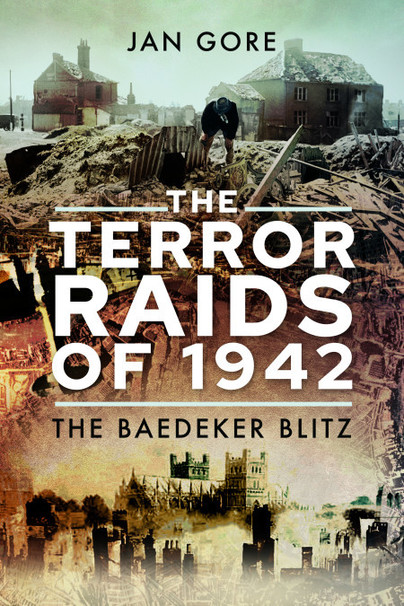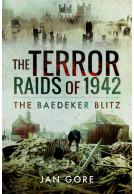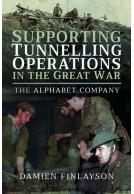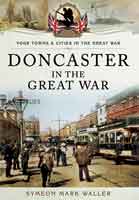The Terror Raids of 1942 (Paperback)
The Baedeker Blitz
(click here for international delivery rates)
Need a currency converter? Check XE.com for live rates
| Other formats available | Price |
|---|---|
| The Terror Raids of 1942 Hardback Add to Basket | £25.00 |
| The Terror Raids of 1942 eBook (10.0 MB) Add to Basket | £6.99 |
‘We shall go out and bomb every building in Britain marked with three stars in the Baedeker Guide’ the German Foreign Office announced in April 1942 as the Luftwaffe attacked Exeter, Bath, Norwich, York and Canterbury. Over a thousand people died. These raids were direct retaliation for RAF raids on equally historic German cities. Hitler had ordered that ‘Preference is to be given…where attacks are likely to have the greatest possible effect on civilian life’ and in this narrow aim – as Jan Gore shows in the first full history of the raids to be published for over twenty years – they certainly succeeded.
She explains the Luftwaffe’s tactics, the types of bombs that were used – high explosive, parachute mines and incendiaries – and records the devastating damage they caused. Her main focus is on the effect of the bombing on the ground. In graphic detail she describes the air raid precautions, the role of the various civil defence organisations and the direct experience of the civilians. Their recollections – many of which have not been published before – as well as newspaper articles and official reports give us a vivid impression of the raids themselves and their immediate aftermath.
Jan Gore’s original and painstaking research provides the fullest insight yet into the impact of this bombing campaign on Britain’s home front during the Second World War.
Author interview featured in The Telegraph
The Telegraph
Featured on WW2 Today
WW2 Today
Featured on Recollections of WWII
Recollections of WWII
"This book is a must for anyone interested in the Baedeker raids".
Despatches, the magazine of the International Guild of Battlefield Guides - Spring/Summer 2021 issue
Rating: 5 out of 5 stars
NetGalley, Robin Price
After Churchill had sanctioned the bombing of civilian areas in a number of German towns Hitler inevitably decided to get his revenge. England's beautiful cathedral cities and places of great historical importance became civilian targets in what is now known as the Baedeker raids.
The book is written with integrity and compassion and concentrates not on statistics but on individual human stories of loss, death or survival. Often these stories are heartbreaking but there are heart-warming moments too. It is a stark reminder that in war there are no victors - only victims.
Rating: 5 out of 5 stars
NetGalley, Susan Johnston
By 1942, London had endured the worst of the Blitz. Thousands of civilians had lost lives and property in the carnage. The decision was made to bomb German cities where the goal was to bring home the costs of the war to the average man. This infuriated Hitler. While he would still focus on cities with strategic value, he decided to target places of historical and cultural heritage too. This was not a knee jerk retaliation. In fact, there had been plans to do this long before the declaration of war. And the source material used to choose the locations was the tourist guidebook, the Baedeker.
The raids that were so named lasted only months but the destruction they wrought would last forever. Cities like Bath and Canterbury were devastated, often with multiple raids over days. Some of the losses could never be recovered. The loss of life was substantial. But if the motive behind the attacks was to weaken morale and break the English people, it fell far short of the mark. There were many raids upon cities from both sides, some with cataclysmic results but never before, nor after, has a guidebook been the catalyst for such an event.
Well written and documented, it tells the story of the people involved, some of them the deceased and some the survivors in their own words. I always find the first hand reports moving. The book also does something quite unusual. It tells the story of a German pilot who took part in the raids but felt such remorse after the end of the war, that he journeyed to the places he bombed to ask forgiveness. After all the death and destruction, it reinforces how people can come together to commemorate and find peace. He turned out to be quite a remarkable man.
One can never understand what either side hoped to achieve by destroying historic cities and killing and maiming their citizens during a conflict such as the second world war. Jan Gore attempts to explain the thinking behind it, and the awful consequences. As an act of retaliation, one can understand it on some levels, but it remains horrific and repugnant. A terrific account.
Books Monthly
I have a strong interest in history especially times during the war. I appreciated the honest accounts of what people experienced.
NetGalley, Niamh Burnett
The authors writing style, really meant that you felt what they went through and what truly happened in the raids.
An insightful view in to what people experienced during these times.
In this highly readable book the author - Jan Gore - does a very good job of reminding the reader that whilst the choice of Baedeker targets in 1942 would appear to be a rejection of civilised mores, it is the innocent people who were injured or killed, many of them children, who deserve to be remembered.
Phil Curme
Read the full review here
Interview article: ‘When Norwich fell victim to the Baedeker Blitz’, conducted by Steve Snelling
Eastern Daily Press and Norwich Evening News, 19th February 2021
Whilst the majority of British people will remember London Blitz, there was also The Baedeker Blitz were a series of attacks by the Luftwaffe on historical English cities during the Second World War. The name derives from Baedeker, a series of German tourist guidebooks, which were used to generate targets for bombing. The raids were planned in response to a devastating increase in the effectiveness of the RAF bombing offensive, starting with the bombing of Lübeck in March 1942. The aim was to begin a tit-for-tat exchange with the hope of forcing the RAF to reduce their actions. This book covers those raids with interjected stories and memories of civilians involved in the bombing and how they managed to cope.
UK Historian
This is a fantastic book to read indeed, I loved reading everything about it from cover to cover. The book is split into different chapters which each look at the various towns involved in the raids. Each raid looks various personal accounts of those that had to go through the drama, which is great because it gives the book a personal quality and meaning to what happened to each town. The book is very well written and looks at the tactics involved by the Luftwaffe, the types of bombs and explosives used and the devastation caused with over 1000 people killed in the raids. There is an excellent photographs section too of the various cities put there is also very good diagrams used that really sell the story although selling the story isn’t needed. Eventually these raids were ended due to the high casualty rate on the side of the Luftwaffe. A really good read and I would highly recommend this book to all with a 5 star rating.
Read the full review here
This book gives homage to survivors and victims of the bomb raids that took place in Great Britian.
NetGalley, Angela Han
I appreciated the personal stories of real people who witnessed the night terror and the devastation on their community. People lost their homes, family, and their own lives during dark times. It was saddening to read through the testimonies!
Whilst most Britons have heard of ‘The Blitz’, the many smaller scale, but nonetheless highly destructive and lethal, raids on other cities across the UK is increasingly only a subject that is appreciated by those who have made a study of this aspect of World War 2. This is particularly the case as those with personal recollections of the raids in Bath, York, Exeter and other cities of cultural significance are by definition now in their 80s and 90s.
NetGalley, K Manley
This book examines the series of raids that came to be know as the Baedeker Raids, taking their name from a famous German tourist guide book, the UK edition of which provided information on areas of cultural significance. Hitler had claimed that the attacks on the Baltic ports of Lubeck and Rostock had little military value and were intended instead to destroy the prized mediaeval cities. In consequence he launched a series of terror reprisal raids, which would have the twofold purpose of destroying culturally significant cities in Britain and terrorising the local populations. The raids, on Exeter, Norwich, Bath, Canterbury and York, were highly destructive and caused significant loss of life. Unusually, because most were, at least initially, lightly defended, the German aircraft are described as using shallow dive bomb and machine gun fire tactics to aid accuracy and cause even more terror to the civilian population.
The book benefits from many personal accounts that serve to bring a degree of realism and authenticity to the descriptions of the attacks. It is one thing to read ‘casualties were limited to just over a hundred dead’; it is something else entirely when someone who was a child at the time describes the bomb explosion that killed three of his family members and destroyed his house. It is also striking to read of the many examples of heroism or simple voluntary tasks, such as firewatching, that carried significant personal risk.
This is a valuable book that provides an insight into just one strand of the non-London Blitz. It is, of course, difficult to read these accounts without also sparing a thought for the German civilians who would experience even more persistent and extreme bombing as the RAF made good on Air Marshall Harris’s promise that, having sown the wind in the early days of the war, Germany would ‘reap the whirlwind’.
This is an intense read.
NetGalley, Natalie Power
Its got the witnesses and survivors recounting what they say on that night/day.
Reading what these people saw and went through is hard. Its explains things really well so you can imagine what it was like.
An excellent book, meticulously researched by the author. The book puts the voices of those living through the raids, their relatives and news at the time, at the forefront and relays a vivid picture of the horror and destruction caused to people, their homes and livelihoods. It includes information about the context of the raids, and the reasons for them, without detracting from people’s personal experiences. The book is written in a way that makes it accessible to many people, whilst also being respectful of people’s accounts and the impact of the raids on their lives.
Julia Wright
JRW
As featured in the Eastern Daily Press, 19th February 2021 (page 1)
As featured in the Eastern Daily Press, 19th February 2021 (page 2)
About Jan Gore
Jan Gore is a researcher, writer and lecturer who has compiled biographies of those who died (both civilians and military) during the Second World War in Bournemouth and Exmouth as well as in the V1 attack on the Guards’ Chapel in London. In the past she has worked for GCHQ and Chatham House and has been a civil servant and librarian. For some years she lectured in French at Kingston University. Her first publication for Pen & Sword was "Send More Shrouds; The V1 Attack on the Guards’ Chapel 1944." She then wrote "The Terror Raids of 1942: the Baedeker Blitz"; this will be due out in paperback in September 2024. Her latest book is about the V1 campaign, 1944-1945; this will be due out in August 2024.


















